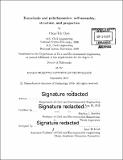Eumelanin and polydopamine : self-assembly, structure, and properties
Author(s)
Chen, Chun-Teh
DownloadFull printable version (19.81Mb)
Other Contributors
Massachusetts Institute of Technology. Department of Civil and Environmental Engineering.
Advisor
Markus J. Buehler.
Terms of use
Metadata
Show full item recordAbstract
In this thesis, a detailed hierarchical structure of eumelanin is described and validated in molecular dynamics simulations. For the first time, the gap between primary, secondary, and aggregate structures of eumelanin is bridged. Based on the hierarchical structure, a new explanation of the photoprotective function of eumelanin is proposed. The interplay of geometric order and disorder characteristics of the hierarchical structure results in significant and random excitonic couplings among eumelanin protomolecules. Consequently, these couplings broaden the spectrum and give rise to a relative enhancement of absorption intensity at the higher-energy end. To provide a more in-depth understanding of the structure-property relationship for exploring practical applications of synthetic eumelanin, polydopamine (PDA), a model that mimics the polymerization mechanism of eumelanin via controlled in silico covalent cross-linking is presented. The results show the possibility of tuning the molecular structures and mechanical properties of eumelanin by controlling the extent of polymerization. Since the lack of well-defined and readily available structures for eumelanin has hindered the progress of computational studies in this field, a set of more realistic molecular models for eumelanin is proposed. A brute-force algorithm is used to generate and evaluate probable molecular structures of eumelanin. The most stable dimers, trimers, and tetramers of eumelanin protomolecules are identified. The results show that more planar molecular structures have a tendency to be more stable; thus, they are more likely to exist. Combining these molecular models, the heterogeneous nature of eumelanin as well as the structural planarity of its protomolecules can both be satisfied. One of the most extensively studied applications of PDA is in the form of a component in graphene oxide (GO) nanocomposites. Here, explanations of the enhanced mechanical properties and shrinking ability in response to the environmental humidity of GO-PDA nanocomposites are proposed.
Description
Thesis: Ph. D., Massachusetts Institute of Technology, Department of Civil and Environmental Engineering, 2016. Cataloged from PDF version of thesis. Includes bibliographical references (pages 177-187).
Date issued
2016Department
Massachusetts Institute of Technology. Department of Civil and Environmental EngineeringPublisher
Massachusetts Institute of Technology
Keywords
Civil and Environmental Engineering.